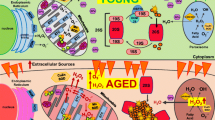Summary
Aging is the progressive accumulation of changes with time that are responsible for the ever-increasing likelihood of disease and death. These irreversible changes are attributed to the aging process. This process is now the major cause of death in the developed countries. This fact is obscured by the protean nature of the contributions of this process to the events which terminate life.
The aging process may be due to free radical reations. This theory is supported by: 1) studies on the origin and evolution of life; 2) the numerous studies of the effect of ionizing radiation on living systems; 3) life span experiments in which the diet was modified so as to alter endogenous free radical reaction levels; 4) the plausible explanations it provides for aging phenomena; and 5) the growing number of studies which implicate free radical reactions in the pathogenesis of specific diseases.
The relationship between aging and diseases involving free radical reactions seems to be a direct one. Modulation of the normal distribution of deleterious free radical reaction-induced changes throughout the body by genetic and environmental differences between individuals results in patterns of change, in some sufficiently different from the normal aging pattern to be recognized as disease. The growing number of ‘free radical’ diseases includes the two major causes of death, cancer and atherosclerosis.
It is reasonable to expect on the basis of present data that a judicious selection of diets and antioxidant supplements will increase the healthy, active life span by 5–10 or more years.
Similar content being viewed by others
References
Harman D: The aging process. Chem and Engineering News 65, No. 17:2, 1987
Harman D: Aging: a theory based on free radical and radiation chemistry. J Gerontol 11:298–300, 1956
Harman D: Role of free radicals in mutation, cancer, aging, and the maintenance of life. Rad Res 16:753–763, 1962
Harman D: The aging process. Proc Natl Acad Sci USA 78:7124–7128, 1981
Harman D: Free radical theory of aging: role of free radicals in the origination and evolution of life, aging, and disease process. In: JE Johnson Jr, R Walford, D Harman and J Miquel (eds.). Free Radicals, Aging and Degenerative Diseases. Alan R. Liss, New York, 1986, pp. 3–49
Nohebel DC, Walton JC: Free Radical Chemistry. University Press, Cambridge, Massachusetts, 1974
Pryor WA: Free Radicals. Raven Press, New York, 1966
Casarett GW: Similarities and contrasts between radiation and time pathology. In: GL Strehler (ed.). Advances in Gerontology Research, Clarendon Press, Oxford, 1964, pp. 109–163
Lindrop PJ, Rotblat J: Long term effects of a single whole-body exposure of mice to ionizing radiation. Proc Roy Soc (B) 154:332–349, 352–368, 1961
Harman D: Free radical theory of aging: consequences of mitochondrial aging. Age 6:86–94, 1983
Harman D: Free radical theory of aging: effect of free radical inhibitors on the mortality rate of male LAF1 mice. J Geront 23:476–482, 1968
Comfort A: Effect of ethoxyquin on the longevity of C3H mice. Nature 229:254–255, 1971
Heidrick ML, Hendricks LC, Cook DE: Effect of dietary 2-mercaptoethanol on the life span, immune system, tumor incidence and lipid peroxidation damage in spleen lymphocytes of aging BC3F1 mice. Mech Ageing Dis 27:341–358, 1984
Emanuel NM: Free radicals and the action of inhibitors of radical processes under pathological states and aging in living organisms and in man. Quart Rev Biophysics 9:283–308, 1976
Emanuel NM, Duburs G, Obukhov LK, Uldrikis J: Drug for prophylaxis of aging and prolongation of lifetime. Chem Abstr 94:9632a, 1981
Harman D: The biological clock: the mitochondria? J Amer Geriat Soc 20:145–147, 1972
Horrum MA, Harman D, Tobin RB: Free radical theory of aging: effects of antioxidants on mitochondrial function. Age 10:58–61, 1987
Harman D, Eddy DE: Free radical theory of aging: beneficial effect of adding antioxidants to the maternal mouse diet on life span of offspring; possible explanation of the sex difference in longevity. Age 2:109–122, 1979
Harman D: Free radical theory of aging: beneficial effect of antioxidants on the life span of male NZB mice: role of free radical reactions in the deterioration of the immune system with age and in the pathogenesis of systemic lupus erythematosus. Age 3:64–73, 1980
Harman D: Free radical theory of aging: the ‘free radical’ diseases. Age 7:111–131, 1984
Kohn RR: Cause of death in very old people. JAMA 247:2793–2797, 1982
Halliwell B: Oxygen radicals and metal ions: potential antioxidant strategies, pp 526–530, in CE Cross, moderator, Oxygen radicals and human disease. Ann Intern Med 107:527–545, 1987
Author information
Authors and Affiliations
Rights and permissions
About this article
Cite this article
Harman, D. Free radicals in aging. Mol Cell Biochem 84, 155–161 (1988). https://doi.org/10.1007/BF00421050
Accepted:
Issue Date:
DOI: https://doi.org/10.1007/BF00421050




